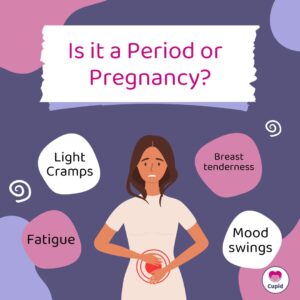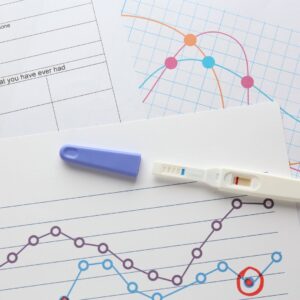 How to tell if you’re pregnant before your test does. Skip the old wives’ tales and take your temperature!
How to tell if you’re pregnant before your test does. Skip the old wives’ tales and take your temperature!
Is it period or pregnancy? The two week wait struggle saga continued:
The symptoms are nearly the same light cramping, spotting, breast tenderness to name a few. You made it through the two week wait and you are about to expect your period. It can be super frustrating, feeling like your pregnant and then your period arrives later that evening. In one day you can feel excited and hopeful, and just a few hours later upset that Aunt Flo arrived. It can be a roller coaster of emotions to say the least.
So when should you check for pregnancy? Ideally you should wait until you miss your period, but some women can get a positive pregnancy test 10 days after conception. If you have a 28-day cycle, that would be approximately 4 days before you expect your next period. Testing any sooner than 4 days before your missed period would not be accurate.
Let’s break down the two week wait. The two-week wait is the two weeks after trying to conceive and before you expect your next period to start.
Say your period is not due for a few more days, but you start to feel bloated and tender breasts. It can be such a confusing time because period symptoms and early pregnancy symptoms are so similar. I recall feeling a sharp pain in my pelvis before my nursing shift early in the morning about 10 days after conception. This is called implantation cramping. It can be felt around 6-12 days after conception. Most women feel a mild cramping, pulling or tingling sensation in their middle lower abdomen that can last up to a couple hours to days.
The few days leading up to your period you may feel pregnant, because the symptoms are nearly the same. Is there any way to tell if you are pregnant versus just feeling normal premenstrual symptoms?
Well maybe one symptom will help you to differentiate between the two. Some women feel lightly nauseated with early pregnancy. Additionally, some women have implantation bleeding or light spotting. Those symptoms can help you to know if you are experiencing early pregnancy versus premenstrual symptoms. Although those symptoms can still be your body preparing for your period minus the nausea. It’s funny though, you can almost make yourself feel any symptom if you try hard enough, the power of suggestion is ironic. I swore I felt some stomach issues during the two week wait and it was just Aunt Flo telling me she was en route.

One hallmark sign you can rely on for ovulation and early pregnancy is a rise in your basal body temperature. If you chose this method to check for pregnancy, accuracy is key. You’ll need a standard oral thermometer that checks two decimal points, or a “basal body” thermometer. You’ll need to check your temperature at nearly the same time every morning shortly after waking up. Do not eat or drink anything before checking it, or brush your teeth. Also you’ll need to get out of bed, because if you’re under a lot of blankets that will hinder accuracy. You will notice a rise in your usual body temperature of about half a point aka 0.5 of a point when you ovulate all the way through your missed period and into a pregnancy. This rise in temperature will continue throughout the pregnancy. If your period is coming you will have a drop in your temperature back to your normal temperature.
Basal body temperature increases to between 97.6°F (36.4°C) and 98.6°F (37°C). Basal body temperature will drop again if pregnancy doesn’t happen.
This means that you need to know what your baseline or what your usual body temperature is on a regular basis. On average most women’s temperature before ovulation averages between 97°F (36.1°C) and 97.5°F (36.4°C). I always notice that a few nights out of the month I sleep hot or wake up sweating. I guess I can blame that on my hormones, and a rise of half a degree of my temperature!
You may want to log your temperature on a piece of paper, or your calendar on your phone. Once you establish what your normal temperature is, you only need to check temperature near ovulation and after trying to conceive all the way up until your period or pregnancy. This would be approximately 2.5 weeks out of the month.
Checking your temperature is the only way to find out if your body is preparing for pregnancy during the two week wait. Accuracy is key while taking your temperature, and be aware that an increase of temperature is only a sign that pregnancy could be occurring. Of course you still need to wait until at least four days before your expected period to take a pregnancy test. Ideally though try to wait until you miss your period, for better accuracy. If you have been trying to conceive for a while you know that supplies such as pregnancy tests can add up, and you may want to wait until a missed period as not to increase expenditures.
Premenstrual symptoms and early pregnancy symptoms can feel the same and those few days leading up to your next period can be a confusing time. One moment you can feel excited about tender breasts and later that evening disappointed by Aunt Flo’s arrival. Hang in there friend!
Please check out all our latest offers and blogs. The Cupid aka Cup Insemination Device is the only one step method for at home insemination. Subscribe to all our channels to stay in the know, such as our giveaway for our TTC Testing bundle on socials this week!
We hope this article has helped in your journey to pregnancy, if you need infertility support please visit www.resolve.org for their many options.
Happy Conceiving!

